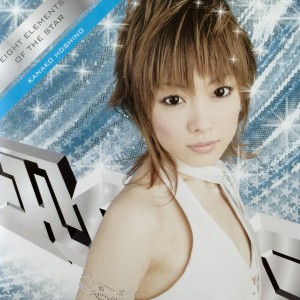Eight Elements of the Star
 |
Album Title: EIGHT ELEMENTS OF THE STAR |
| Record Label: Konami Digital Entertainment |
|
| Catalog No.: LC-1479 |
|
| Release Date: July 28, 2006 |
|
| Purchase: Buy at Amazon |
Overview
EIGHT ELEMENTS OF THE STAR is the first solo release by Hoshino Kanako, taking the form of a mini-album. The album mostly contains full versions of Kanako’s Bemani songs, with just a couple of new compositions. All of the songs are composed by Bemani artists. The album is madeup of pop songs and that traverse just a few styles, and for anyone who enjoyed Kanako’s work from the various Bemani games, the album should be satisfying.
Body
The album opens with “~T・A・I・Y・O~” by NAOKI, one of the album’s Euro tracks. As with each of the other extended tracks, this one receives a new second verse to fill out the track time, but also a significant amount of polishing in sound, making it much clearer and better balanced than its original beatmania IIDX counterpart. Some of the instrumentation has also been changed a bit (most notably at the chorus), but the changes are small and not too consequential. It’s a strong track with a memorable melody and good energy. “Gekkou” with Tatsh is another of these Eura tracks, a bit more serious and dramatic with some reference to Beethoven’s “Moonlight Sonata” as included. It’s not much different from its in-game counterpart other than the new verse and a short new guitar solo, but that’s just fine for the track which was already good. “Regret” with DJ YOSHITAKA is a decent track but the least impressive of these, mostly because the melody is doesn’t push Kanako’s voice very much, leaving it all sounding rather flat dynamically. It’s otherwise adequately made, and a bit more polished on the album than the original with a new guitar solo as well.
Kanako also includes a few tracks that are more standard pop fare. “D.A.N.C.E.!” is a bit laid back club track, and even includes a short rap by Yoshitaka. The many sampled sounds work together to make a pretty infectious song, although it can feel a bit cheesy at times. “INFERNO” with Yoshitaka and Tomosuke Funaki is a bit more interesting as a house track with Brazilian influences. Each of the artists brings their best to the table, and it pays off in this very fun song. The bridge breakdown is very noticeably different from the game version of the track, now being a more reduced atmospheric segment, which I actually prefer to the game version’s oddball bridge.Then there is the full version of “Tashikanamono”, which is a collaboration written by Tatsh but also featuring many main Bemani artists on the various instruments. This track is a bright and positive pop rock song and probably the catchiest track on the album (which is saying something), and I am glad to see it represented in full here.
In the midst of the Bemani tracks are two original tracks, both composed by Tatsh. First is “Hakugen”, which is the only ballad of the album. The song has decent melodic lines and Kanako sings well enough, but the arrangement doesn’t hold up as well, being very generic and even sounding rather cheap in its instrumentation. The other song “Hello Again ~only one for you~” is a more fun summery track with light instruments and a breezy sound, but despite its inviting arrangement it has an unimpressive chorus that really lets the song down. In the context of the album these tracks feel like filler, and while they diversify the album a bit more, they are easily skippable.
Summary
EIGHT ELEMENTS OF THE STAR is a decent album for fans of Kanako and J-Pop, but it probably won’t impress anyone else. The tracks are solid but standard fare in their respective styles, and are reasonably catchy. The extensions to the tracks are all fine, and a few really benefit from having a remastered sound. The two new tracks are the weakest of the album, but those are not meant to be the draw of the album anyways. If you’re a fan of Kanako’s work and want to have her Bemani songs in full, by all means check out the album.
Do you agree with the review and score? Let us know in the comments below!
3
Posted on July 20, 2015 by Christopher Huynh. Last modified on July 20, 2015.














